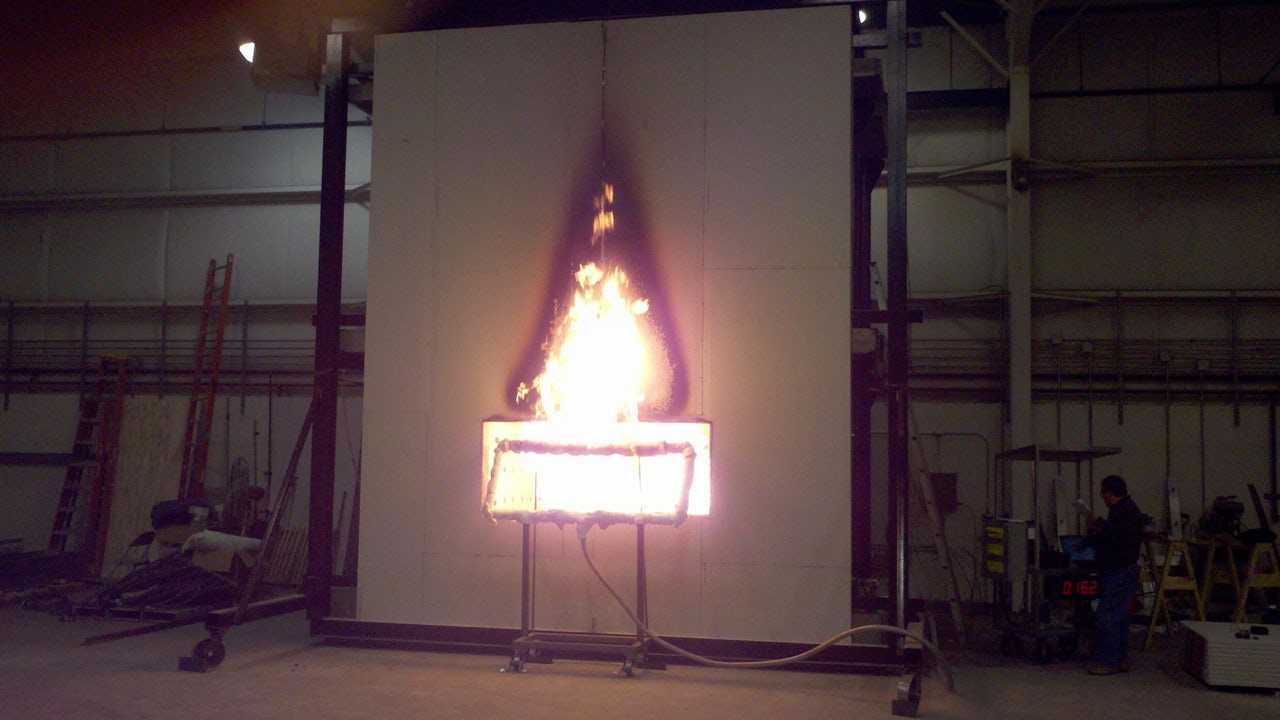Alucobond is the Kleenex of aluminum composite material: comprising two sheets of 0.02-inch-thick aluminum thermobonded to a core material, Alucobond has become synonymous with ACM. One reason why the brand is so trusted by the design community is that it has long been used to resist fire. Just several years after the product’s 1964 launch, for example, the Zurich hotel Novapark specified 500 units of Alucobond to encase its televisions: the sheaths allowed hotel visitors to stub out their cigarettes on guestroom TVs like so many ashtrays.

Since about the same time, Alucobond has also been actively improving the fire-retardant properties of its product for exterior wall panel applications. Research with PVC cores in April 1969 ultimately led to the launch of Alucobond SB1 and its American equivalent of the fascia, known as Alucobond 21.

MassArt Residence Hall in Boston, by ADD, was clad in custom-colored Alucobond Plus ACM. Photo courtesy Kate Hensley
Today, Alucobond can be specified with one of two types of core products for façades: standard polyethylene (PE) and fire-retardant Plus. While both materials are regulated by the International Building Code (IBC), choosing one core over another depends on several factors. The three major criteria are: panel height above grade or grade plane; fire-rated versus non-rated wall assembly; and the distance between the building exterior and the property line or to other structures on site.

For Bauhaus Fachcentrum Berlin in Germany, Müller Reimann Architekten used dimensional Alucobond Plus in Brilliant Silver Metallic. Photo courtesy 3A Composites/Alucobond
According to the 2012 edition of the IBC, a PE core is permissible when construction conditions fall within defined limitations. Take panel height above grade or grade plane. Several sections of the IBC permit PE core material on all construction types to a height of 40 feet above grade plane, as long as fire separation distance — that third criterion — measures five feet or greater. Meanwhile, for heights between 40 and 50 feet above grade or grade plane, IBC Section 1407.11.2 allows for standard core material, as long as section size and vertical separation of sections meet regulation. For building heights greater than 50 feet but less than 75 feet, the 2012 version of the IBC offers two routes to specifying PE cores. Certain occupancy types and fire separation distances allow this standard approach; whether the building is equipped with an automatic sprinkler system throughout, and whether it employs a flame barrier, also influences the choice between PE and Plus material.

When installation conditions do not fall within defined limitations, either the fire-retardant core material must be used or the authority having jurisdiction must provide an approval. A number of specific performance tests are referenced to define allowable use, including several American Standard Testing Methods tests and an intermediate-scale fire test as well as the National Fire Protection Association’s Standard Fire Test Method for Evaluation of Fire Propagation Characteristics of Exterior Non-Load-Bearing Wall Assemblies Containing Combustible Components.
The provisions laid out in the 2012 version of the IBC are markedly different from previous editions, as stricter energy-efficiency requirements have transformed the code systemically. Making the correct choice of core material has become more complex in light of this change — indeed, additional IBC criteria are attached to all of the grade and grade-plane conditions — as has the design of wall assemblies in general.

© Jeffrey Totaro
Ballinger specified Alucobond Plus in custom colors for Penn Medicine Washington Square in Philadelphia. Photo by Jeffrey Totaro
At first glance, the higher sustainability and energy-efficiency standards for architects and construction professionals seem to be slightly at odds with fire protection. The double façades that are hailed for insulating a building, if not properly detailed, can transform into channels through which fire can travel. Photovoltaic panels also present a danger to firefighters responding to an incident.
Yet the increasing demand for high-performing building enclosures actually favors the life-safety features of Alucobond. After all, aluminum is highly durable in original or reused form, which is why 75 percent of all manufactured aluminum is still in circulation; moreover, recycling aluminum consumes only five percent of the energy of producing it anew. By taking fire prevention into account, architects are also preventing the material loss, water consumption and runoff, and emissions that are all associated with a fire event. While complying with new IBC directives is reason enough to pay close attention to sourcing Alucobond with the correct core material, the sustainability ramifications of that decision make scrutiny even more compelling.
See more products from Alucobond on Architizer.









